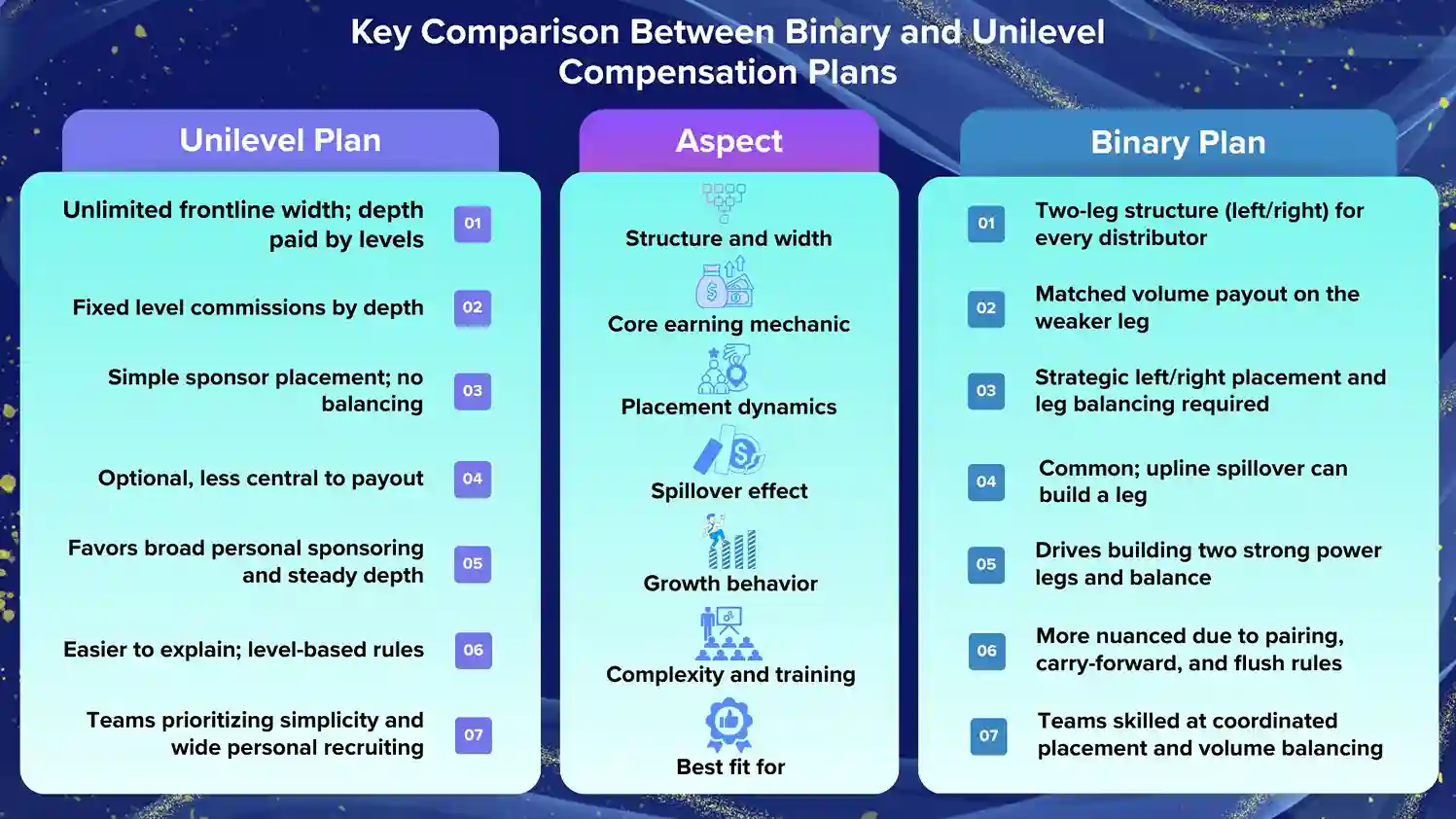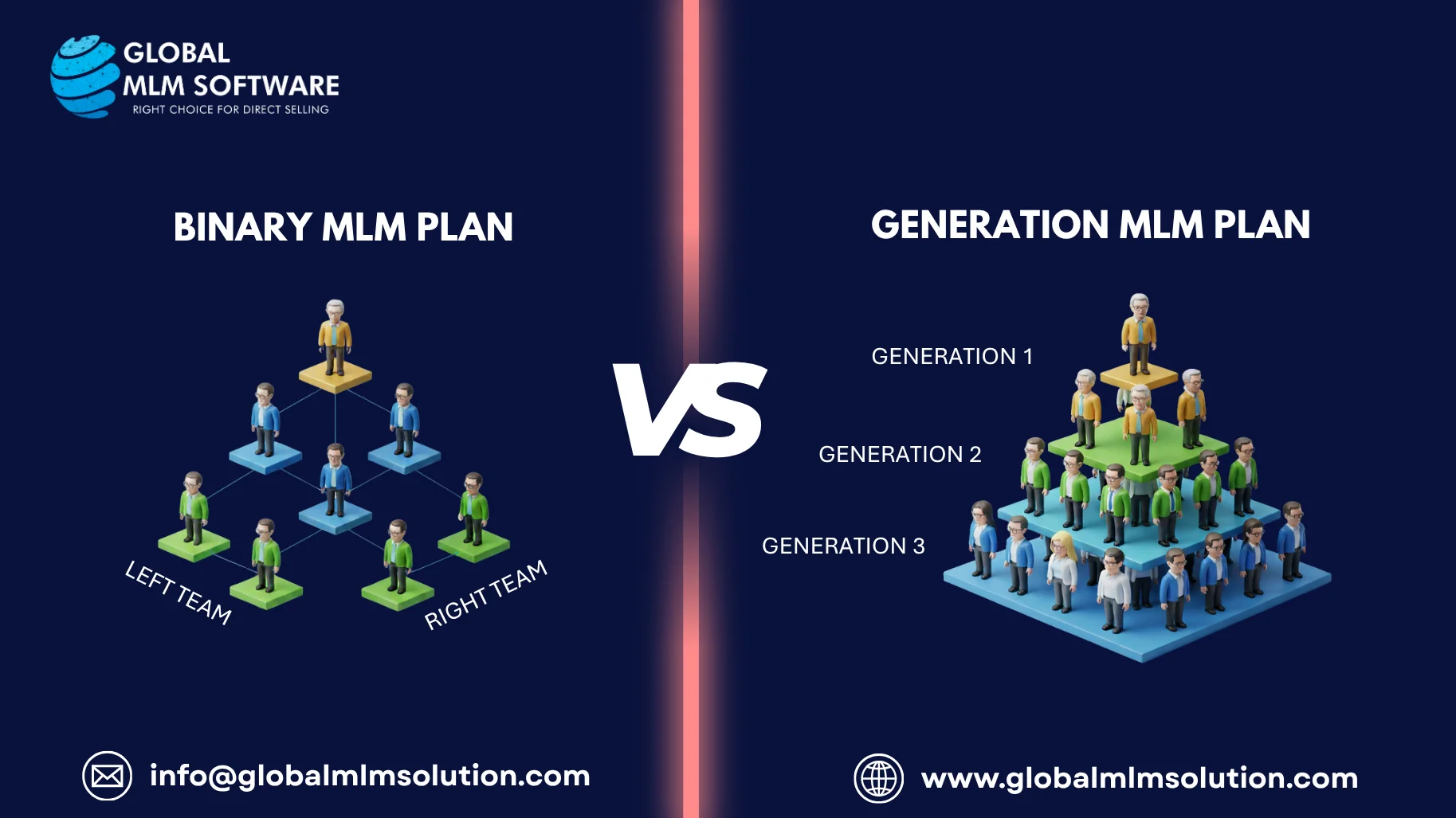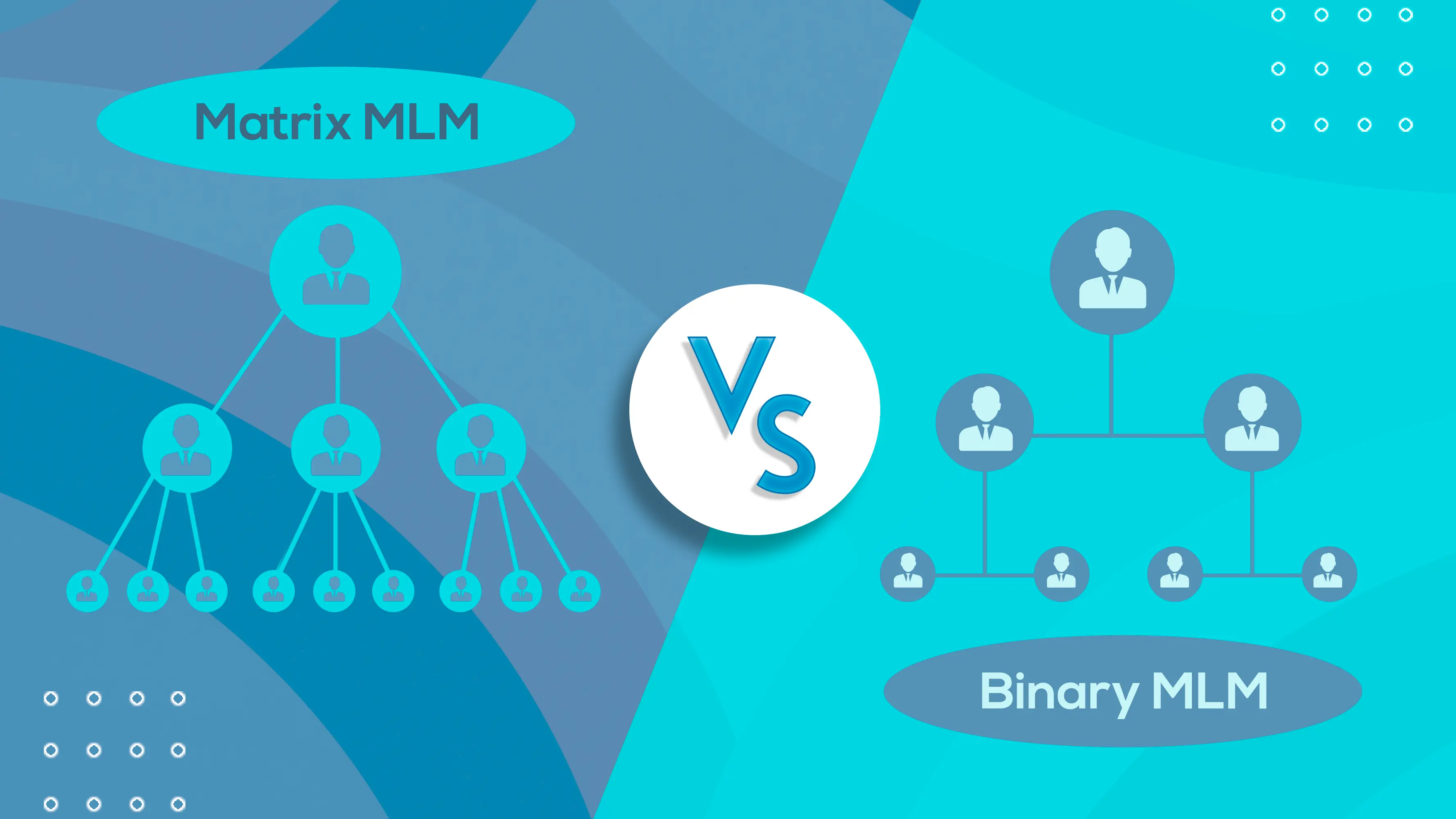When you start researching the multi-level marketing (MLM) industry, you encounter two compensation plans more than others: Unilevel and Binary. It’s partially because they are used by popular companies, such as Herbalife, doTerra, and Mary Kay. Another reason for their popularity is their simplicity and streamlined structuring.
But it’s only their easy structure that’s a common denominator between both plans. In real-world applications, Unilevel and Binary plans are like two faces of a coin, totally different. So, before you choose one of them, make sure you understand their basics and differences.
In this blog, we compare the Unilevel vs Binary compensation plan. While reading, consider yourself as a distributor to understand how both compensation plans work and what makes them different.
This Article Contains:
What is a Unilevel MLM Compensation Plan?
Unilevel means “one level wide” at the top: your direct recruits form your frontline (Level 1). And there is no limit to how many recruits you can place there. The distributors working directly under you and under your distributors together form your downline. Your pay is based on sales made on each level, with the company setting the percentage for each level.
Here’s how recruiting works:
You are the sponsor when you sign up a new person, and that person sits on your Level 1 (your frontline) with no limit to how many you can sponsor.
When someone on your Level 1 sponsors a new person, that new person becomes your Level 2, and this pattern continues as your team grows deeper.
In a Unilevel plan, there is no spillover; therefore, no placing people under you by someone else. Your frontline is built by your own direct sponsorship.
Genealogy tree example:
Imagine you sponsor Ana and Ben, so Ana and Ben are on your Level 1.
Ana sponsors Cam, so Cam is on Ana’s Level 1 but on your Level 2.
Your commission comes as a small percent from Level 1 and a company-set percent from Level 2 and beyond, following the rules in the plan.
Here’s how commission is calculated in Unilevel Compensation plans:
Let us assume that an MLM company pays 10%, 5% and 3% commissions on Level 1, 2, and 3. Based on this predefined criterion, your earnings from your downline will be calculated like this:
You sponsor Ana and Ben, and each places a $100 order, so your Level 1 earnings are (10%×($100+$100)) = $20.
Now, imagine Ana sponsors Cam, who orders another $100 product. As she is at Level 2, your earnings become (5%×$100) = $5.
Further, let's say Cam sponsors Fae, who becomes your Level 3. And Fae also sells products worth $100, then your commission becomes (3%×$100) = $3
Therefore, your total commission is $20+$5+$3 = $28.
Also, if someone on a level is not qualified, dynamic compression moves that commission up to the next qualified upline, so the pay is not lost. And most companies pay on a fixed number of levels, often about five to seven levels, to keep payouts sustainable and simple.
Popular companies that use the Unilevel Compensation plan include:
doTERRA
Young Living
SeneGence
What is a Binary MLM Compensation Plan?
Binary means “two branches”: one left leg and one right leg under you, with only two direct positions on your frontline. When you sponsor more than two people, extra recruits are placed deeper under your team; this is called spillover in a binary MLM compensation plan. Your pay is typically calculated from the smaller leg’s sales volume, called the pay leg, to encourage balance on both sides.
Here’s how recruiting works:
You are the sponsor when you sign up a new person, and you place them in either your left leg or your right leg on your frontline.
After you fill both spots, any extra people you bring in are placed deeper in the tree as spillover under your team.
Teamwork matters because commissions are based on the lower-volume leg, so leaders help balance both legs for steady growth.
Genealogy tree example:
Suppose you sponsor Ana on your left leg and Ben on your right leg, so your frontline has two people.
You then sponsor Cam as a third recruit; Cam must go below Ana or Ben, and this placement is called spillover. The specific placement (under Ana or Ben) is usually strategic and decided by the sponsor to help balance the legs.
As Ana and Ben add their own recruits, your tree grows deeper without any limit on levels.
The commissions are calculated in the Binary plan as follows:
Let us assume a company pays a fixed commission on the weekly pay leg volume, which is the smaller leg’s total sales volume for that week.
If your left leg has 300 points and your right leg has 500 points, the paying leg will be 300 points. So the company applies its set commission only to 300 points.
For example, if the rate is 10%, your weekly binary commission would be 10%×300=30 points (or dollars, as the plan defines).
Many companies also set “capping” rules so commissions do not exceed a weekly or monthly limit, and extra volume may be flushed if it is above the cap.
Popular companies that use the Binary MLM payout structure include:
Atomy
Usana
Isagenix
What is the Difference Between Unilevel and Binary Compensation Plan?

Binary and Unilevel compensation have fundamental and operational differences. Therefore, the growth and day-to-day operations of your MLM business will depend on which MLM income model you choose.
| Aspect | Unilevel Plan | Binary Plan |
|---|---|---|
| Structure and width | Unlimited frontline width; depth paid by levels. | Two-leg structure (left/right) for every distributor. |
| Core earning mechanic | Fixed level commissions by depth. | Matched volume payout on the weaker leg. |
| Placement dynamics | Simple sponsor placement; no balancing. | Strategic left/right placement and leg balancing required. |
| Spillover effect | Optional, less central to payout. | Common; upline spillover can build a leg. |
| Growth behavior | Favors broad personal sponsoring and steady depth. | Drives building two strong power legs and balance. |
| Complexity and training | Easier to explain; level-based rules. | More nuanced due to pairing, carry-forward, and flush rules. |
| Best fit for | Teams prioritizing simplicity and wide personal recruiting. | Teams skilled at coordinated placement and volume balancing. |
How do You Decide Between a Unilevel MLM Plan and a Binary MLM Plan for Business?
You should choose a Unilevel MLM plan if you want unlimited people on your frontline with simple placement and easy rules for new sellers. It is easier to manage, often has predictable monthly pay by levels, and can cost less to run. This plan suits small teams and owners who prefer clear tracking and steady growth by width.
Whereas, select the Binary MLM plan if you like two strong teams called the left leg and right leg, where extra recruits spill over to help depth. Commissions often use the weaker leg’s volume each cycle, so leaders must balance both legs to earn well. Binary can pay fast and support teamwork, but it needs more monitoring, training, and tech to track legs.
Additionally, no matter which plan you choose, using an MLM Software to manage and automate it is one of the best strategies. It helps your business with accurate commission tracking, recruiting, team management, and more.
Conclusion
If you’re looking for the simplest and most straightforward MLM compensation plans, Unilevel and Binary are the ideal choices. These MLM compensation plans are used by industry-leading companies such as doTERRA, Herbalife, Isagenix, and more.
To narrow down one of these two, you’ll need to factor in your requirements. If you need a low to medium level of complexity, Unilevel is the one to choose. Just remember, the downline expansion is slower compared to other direct selling plans.
If you want your distributors to be more skilled and achieve accelerated growth, the Binary compensation plan is your choice, as it has an advantageous spillover effect. Spillover allows for faster downline expansion, and leg balancing encourages teamwork.
FAQs
1. What are the common misconceptions about the Unilevel MLM Plan?
The common misconceptions about the Unilevel MLM plan include:
“Unlimited width means easy money” is a myth because earnings still follow company-set levels and rates, not just how many people sit on Level 1.
“Spillover will fill my team” is incorrect because Unilevel has no spillover, and the frontline is built only by personal sponsoring.
“Pay runs to infinite depth automatically” is wrong because companies cap paid levels, and deeper pay often requires a higher rank.
“Recruiting alone is enough” is risky because all legal MLM businesses require sales volume for the payout.
“Unilevel is the same as Binary or Matrix” is false, because Unilevel allows unlimited frontline width, while those other plans limit placement or width.
2. What are the common misconceptions about the Binary MLM Plan?
The misconceptions about the Binary MLM plan are:
I can have many frontline spots: In Binary, you only have two frontline positions, and extra recruits go deeper as spillovers.
Spillover builds my income for free: Spillover may add volume, but earnings still depend on balanced legs and team effort.
Only the strong leg matters: Commissions are commonly paid on the weaker “pay leg,” so balance is essential.
Width and pay are unlimited without rules: Width is fixed at two, depth can be unlimited, and plans may include caps or flush rules.
Commissions are simple level percentages: Binary uses pairing and weaker-leg volume, which can be more complex to calculate.
Teamwork is optional: Success in Binary MLM compensation requires balancing both legs so growth stays even and sustainable.
Disclaimer: Global MLM Software do not endorse any companies or products mentioned in this article. The content is derived from publicly available resources and does not favor any specific organizations, individuals or products.









